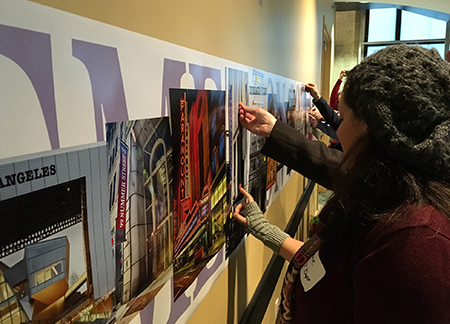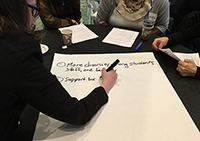Gathering caps week of diversity talk

A participant at the Summit on Race and Difference, held Friday, January 22, at the Bordy Theater, places a sticker on a photo of the Paramount Center to indicate that she recently took part in an activity that addressed diversity, inclusion or social justice. Photo/Erin Clossey
After a week of tough conversations about race and inclusion, faculty, staff, and students from across Emerson College were challenged to take what they learned and put it into action.
During Martin Luther King Jr. Week this year, departments and groups across campus were encouraged to hold Conversations on Race and Difference. On Friday, January 22, the Office of Diversity and Inclusion held a Summit on Race and Difference, and invited participants to debrief each other on their conversations and look ahead together.
“The fact that we are in this room together is an opportunity to make sense of the conversations this week, but also is an opportunity to move forward with due diligence to make change,” Vice President for Diversity and Inclusion Sylvia Spears told the crowd of roughly 75 in the Bordy Theater and Auditorium. “Our shared humanity depends on it.”
On April 28, 2015, a group of Emerson students took over a faculty assembly to protest treatment of students of color on campus, and lack of diversity, among other things. They demanded “cultural sensitivity training” for faculty, and “culturally enlightening classes” for students, according to an article in the Berkeley Beacon.
The Conversations and Summit were, in part, a response to student concerns.
Before participants left on Friday afternoon, Spears asked each of them to sign up for one of several working groups that would come up with specific projects around increasing diversity and inclusion at Emerson, and put them into effect.
But first, Emersonians were praised for the work some of them have already done. Diversity and Inclusive Excellence Director Robert Amelio asked attendees to place stickers on a large poster of photos of Emerson’s many buildings if they’ve recently taken part in any event, discussion, course, or artistic endeavor there around diversity, inclusion, or social justice. Most of the photos were peppered with colorful dots.
“What we want to make sure [of] is a year from now, or six months from now, this thing is covered with dots,” Amelio said.

A Summit on Race and Difference participant makes a list of priorities her table would like to see Emerson College enact. Photo/Erin Clossey
A number of departments were asked to share what they’ve already been doing to improve diversity and inclusion on campus. The Office of the Arts, which administers ArtsEmerson and HowlRound, not only tries to weave inclusion into its staff meetings, but brings in shows that deal with topics of race and diversity, and makes its productions accessible to a wide audience through discounted and free tickets.
The Department of Enrollment Management, as the gateway to the student body, has not just a moral, but a professional obligation to care about diversity, said the department’s vice president, Ruthanne Madsen. The student body currently is 24% diverse, but it should be about 40%, Spears said.
Enrollment Management integrates diversity issues into office activities and social events. They watched the film If These Halls Could Talk, a documentary in which college students of different races and ethnicities discuss race dynamics. They traded holiday traditions at their office Thanksgiving dinner, and posted them at their holiday party. They’re hosting a brown bag lunch to discuss the Oscars, which have come under fire for their dearth of nominees of color.
For all the success stories, however, participants spoke of how difficult it can be to engage around issues of race and difference.
First-year student Leah D’Sa, speaking at a break-out session with her table, said that often the people who take part in conversations and activities around diversity are the people who already know how important it is.
“It would be nice to see more people [involved] who are unfamiliar with it,” D’Sa said.
Lucie Pereira ’18, said she’s met a lot of people who are afraid to talk about issues around race.
“I thought that was so sad, because you’re not going to learn about issues unless you talk about it,” Pereira said.
Other tables talked about how power differentials have to be acknowledged when talking about difference, the responsibility that comes with privilege, and the importance of moving on from just talking about inclusiveness and social justice.
At the end of the Summit, Amelio asked each table to come up with three to five action items that they’d like to see the College commit to working on.
Groups said they wanted to see more diversity among students, faculty, and staff, and more financial aid offered for students in need. They wanted a public forum to address diversity that includes students, and better integration of diversity issues into coursework. Other ideas included a required cultural competency course in the curriculum, more support for students experiencing “culture shock,” and an end to “coddling white people.”
It may have been the “choir” that showed up at the Bordy Theater on Friday, but that choir still has an important function, Spears said.
“The choir has work to do, and the choir’s work is to get more people into the conversation,” she said.
Categories